1 + 23Reading: Think Python Chapters 1, 2, 3, 6
The interpreter lets you type in a short amount of Python code to be immediately executed. It looks like this:

It is like a calculator, but much more powerful. Simple calculator-like math works the way you might expect.

We will show Python in these notes in a similar format:
Math and numbers work in the interpreter, but word-like text doesn’t. Trying it will give you an error.

To work with text in Python, you will need to encapsulate the text in quotation marks, single, or double:
The interpreter always displays the result of the expression you type in (if there is no error). This is different from using a print statement.
The difference between the string "Hello world." as an expression and the print statement print("Hello world.") is subtle when using the interpreter: quotation marks at the output.
The interpreter is a text interface to your computer. You type text, and the output displays text.
This is different from the graphical interfaces you are probably used to using, where there are buttons for you to click on, and you can drag and drop files.
Why use a text interface? It is more powerful. You can give your computer very specific instructions.
Graphical interfaces are designed to be easy to use, but they can only give the computer pre-defined instructions. If you want to solve a problem that hasn’t been solved before, you will probably need to use a text interface to succeed.
The editor lets you write full Python programs. A program is a series of instructions that can be saved for future use. The interpreter is a great tool for experimenting, but most of your coding will be done in the editor.
An editor for Python (or any programming language) has several useful features that a normal “text editor” doesn’t have.
Syntax highlighting changes the color of the text based on what it does in the program.
Line numbers help you organize your code, and help you find and fix errors.
Running programs directly from the editor makes your life easy. There’s a way to run programs from outside the editor, too, but we will save that for later.
Here is an example of a short Python program written in VSCode:
Visual Studio Code:
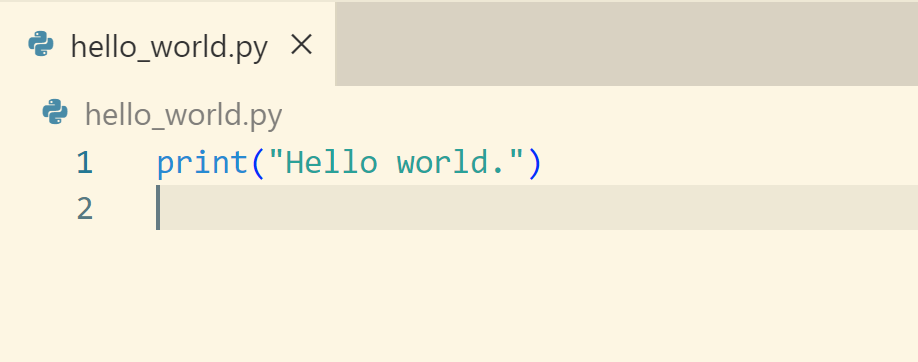
When you run this program, you’ll get printed output displayed at the terminal/shell:
Hello, world.An important note: Python programs (not in the interpreter) only result in printed output when we instruct them to print with a print statement.
Here’s a program with just an expression, and no print statement:

The program will run with no errors, but there will be no printed output.
The Python interpreter is much more than a calculator. We can see how it works by looking at some elementary math.
Consider the mathematical expression \((4 + 2) \times 3\). We can express this in Python in a very similar way:
The parentheses are important, without them, we would be evaluating a different operation:
In the conventional order of operations, multiplication occurs before addition. Without the parentheses, Python firsts evaluates the simple expression 2 * 3:
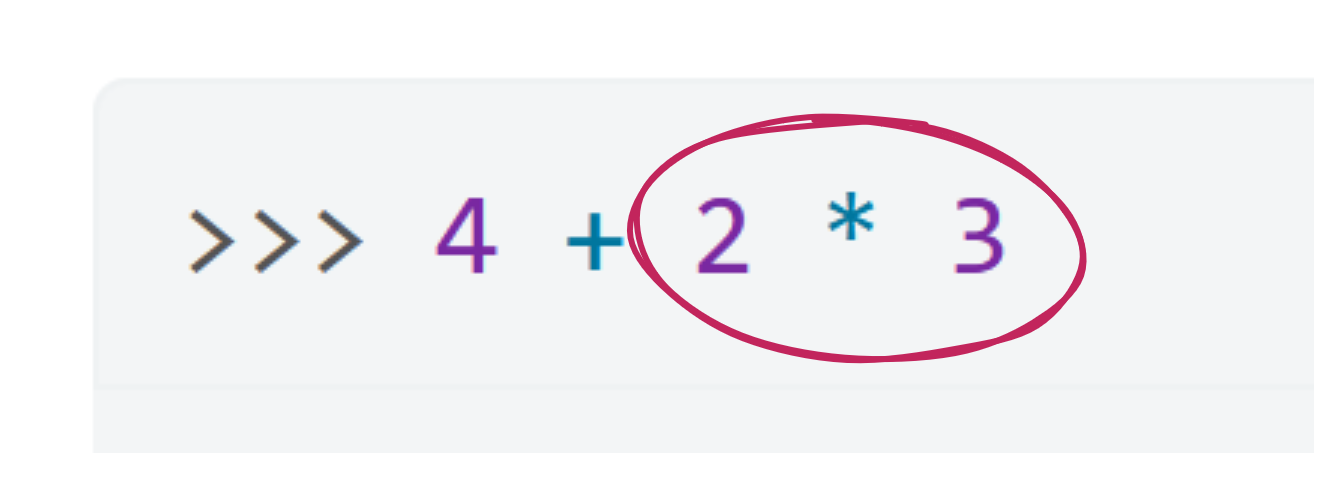
and then ‘replaces’ that expression with its result before evaluating the next expression:
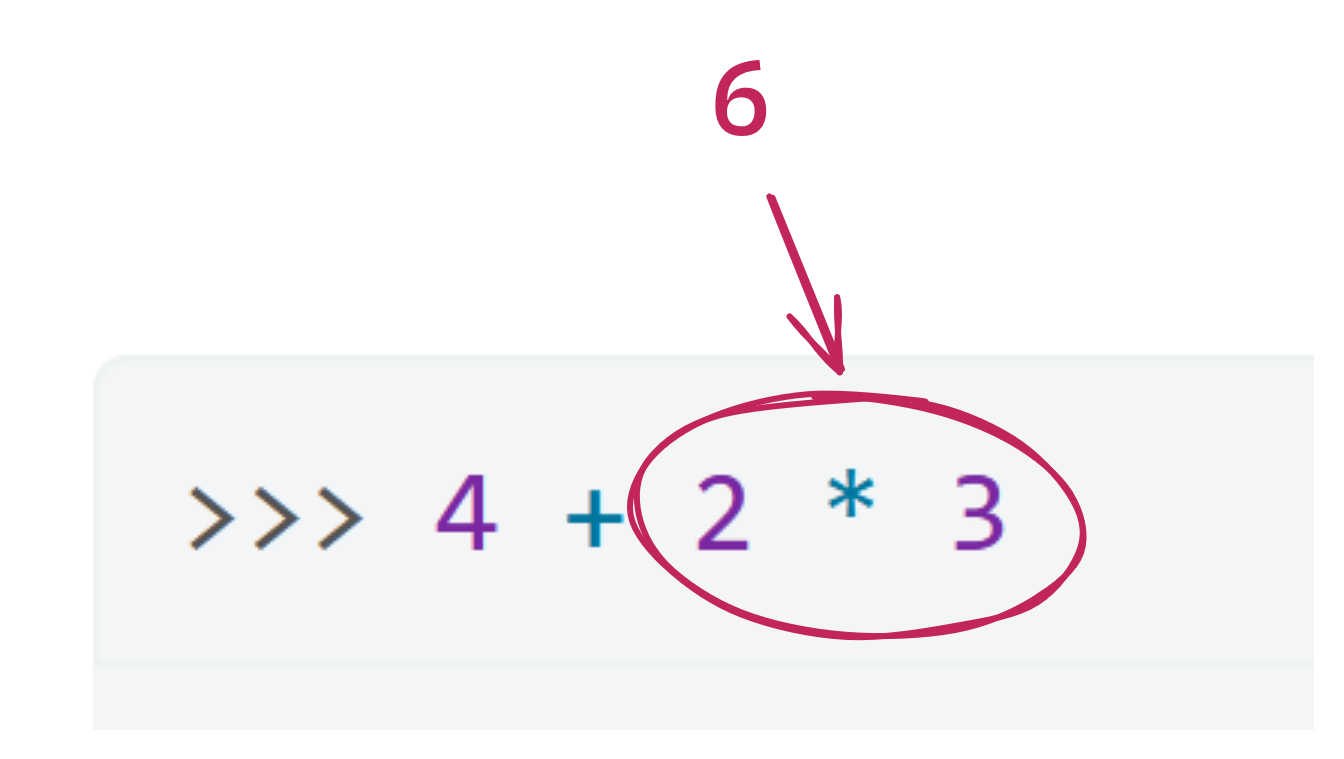
By adding the parentheses, we tell Python to evaluate the expression inside the parentheses first, and then replace that expression with its result.
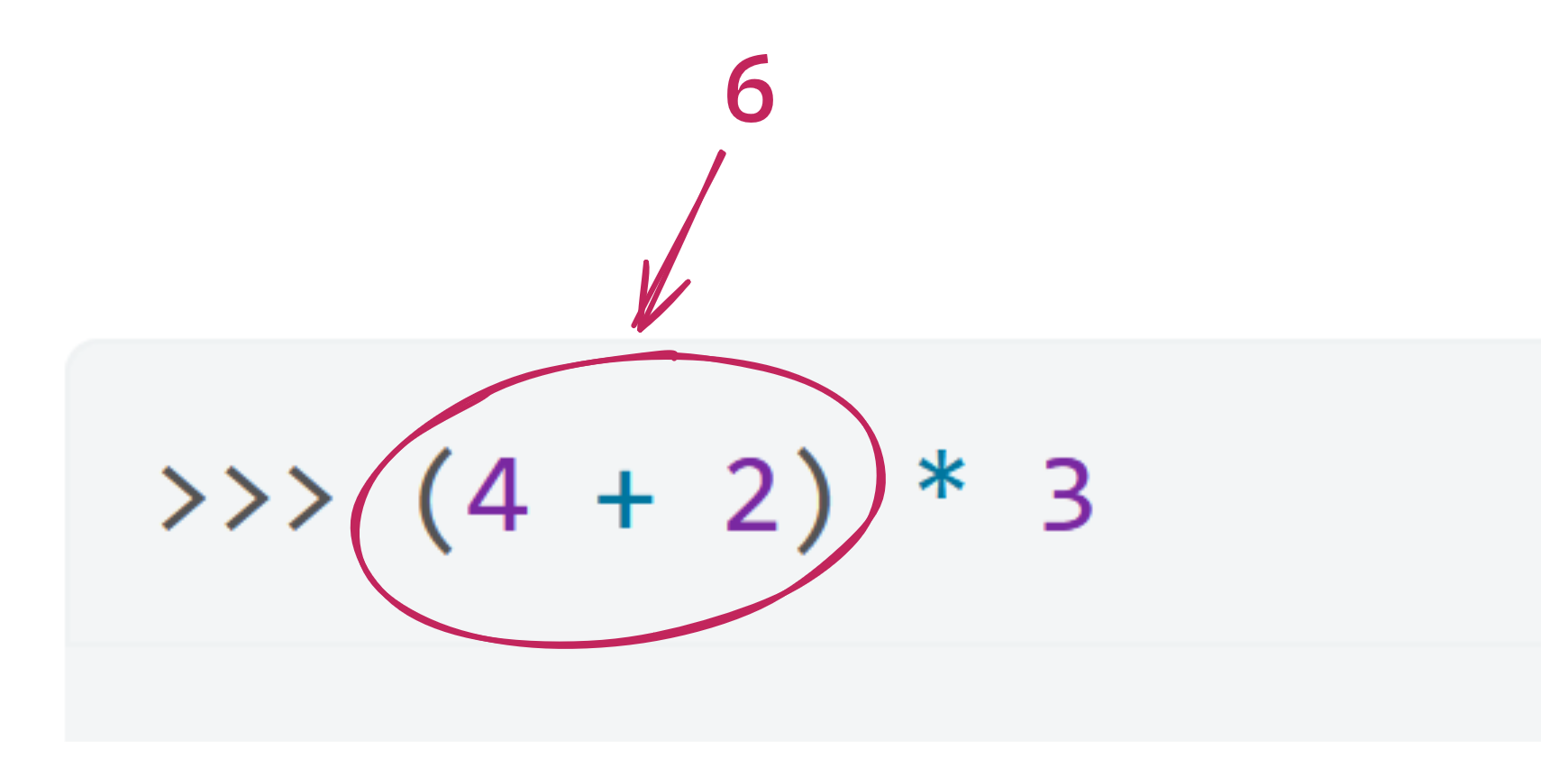
You will never explicitly see a sub-expression replaced by its result. This only happens “under the hood” when Python runs your code. However, you can always try out sub-expressions using the interpreter to make sure your code is doing what you want it to do.
Remember: when in doubt, use parentheses to explicitly instruct Python the order for evaluating expressions. You will end up using parentheses for much more than just simple math.
A basic way to craft expressions in Python is with operators. Many operators look and behave (almost) the same way in Python as they do in math.
| Operator | Function (with numbers) |
|---|---|
+ |
Addition |
- |
Subtraction |
* |
Multiplication |
/ |
Division |
** |
Exponentiation |
// |
Quotient |
% |
Remainder |
You should know how these operators work with numbers. They will work differently (or not work at all) with other kinds of data, which we will see later. For exams in the class, you will never need to do anything more than basic arithmetic and counting.
.py) file that appear to be blank, such as spaces, tabs, and carriage returns.These expressions are equivalent:
Python does not care if your code is easy for humans to read, but you should care. The code below will run, but you should avoid inconsistent spacing, because it makes the code difficult to read. If you start working on a problem, stop, and come back to it later, you will want to be able to read your own code.
In Python, by placing characters (including numbers) between quotation marks, we form strings, text data. You can use single or double quotation marks, but they must match.
Both of these will work:
But this gives us an error:

We can use some mathematical operators with strings, but the behavior may not be intuitive. Strings are not numbers.
For now, let’s use the + operator. It concatenates (attaches end-to-end) two strings.
Wrapping numeric characters with quotation marks means those numbers are interpreted as text:
Mixing numbers and strings with the + operator will give you an error.

Remember that while the interpreter will always show you the result of an expression, you need to use print statements for your programs (in the editor) to have any output.
Whatever is inside the parentheses of the print function will be evaluated, and the result will be printed to the console. The expression (or value) inside the print statement does not need to result in (or be) a string!
Notice that after each print statement, the next print statement appears on a new line.
The result of an expression can be assigned to a variable for later use.
Variable x has been assigned the value 4. When we reference x in an expression, that value is retrieved:
The assignment operator = is not the same as mathematical equality. It works like this:
= is evaluated=This means that we can write Python code that doesn’t translate directly to a math equation:
3 + 1 was evaluated and x was assigned 4.
x + 1 was evaluated: x was 4, so x + 1 became 4 + 1. After evaluation, x was assigned 5.
The idea of variables having different values at different times during program execution is called state. In the interpreter, state is maintained (variable names are saved) until you change them with a new assignment, or you restart the interpreter. When running a program you write in the editor, state is reset each time you run the program.
Variables do not exist until you first assign them. Referencing a variable you haven’t assigned will yield an error:

Variable names are text, but they are not interpreted as text. However, if you put a variable name in between quotation marks, that tells Python to interpret the name literally, as a string, with no connection to the variable.
Not all ‘names’ are valid for variables: the textbook goes into more detail. In general, start variable names with a letter.
This is a place that whitespace is important: the space after a variable name indicates the end of the name. This means you cannot have a space in the name. To get around this, use underscores:

Functions are pre-defined sequences of instructions. Like variables, functions have names, and functions must adhere to the same naming convention. We can call a function with the following syntax:
None is returnedUnless you define a function called function_name() when you run the code above, you’ll get an error.
Functions can form parts of expressions:
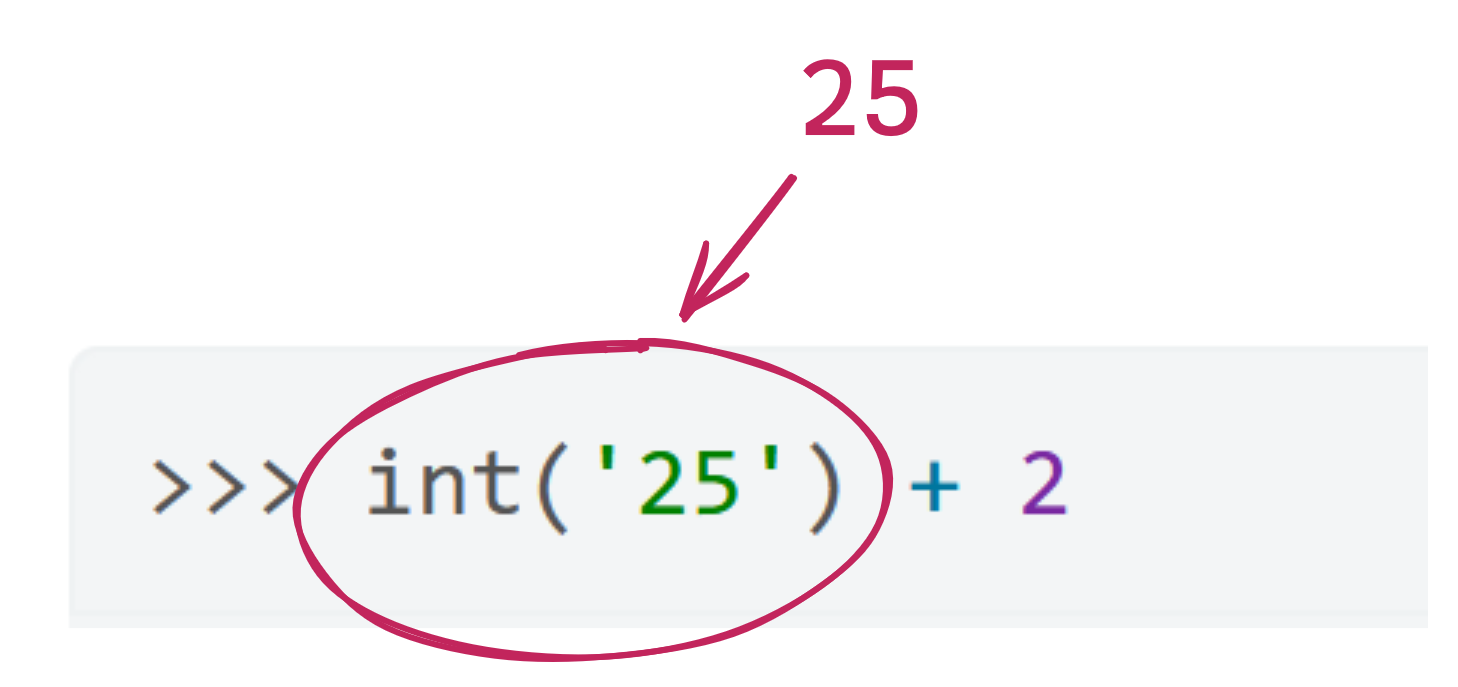
Since int('25') returns the integer 25, after the function call, this is equivalent to:
Expressions can form the arguments of function calls:
The expression '2' + '5' is evaluated before the function call. It is inside the parentheses of the call, and function call parentheses respect order just as expression parentheses do.
After the evaluation, the result becomes int('25') + 2, identical to the first example. As always, these intermediate steps will never be shown to us by Python, but it’s important to understand how the programming language works.
There is no limit to how deep you can nest function calls and expressions:
In practice, however, writing and reading this sort of deeply-nested function call is difficult, and unnecessary. Instead, use variables:
Python comes with a built-in module, math, for simple mathematical functions. The module comes with functions and variables.
To import a module, use the import keyword, followed by a space, followed by the module name:
You only need to do this once in the interpreter, or once at the beginning of a program you write in the editor.
After importing the module, you can use its functions:
Note the syntax: there is a dot in between the module name math and the name of the function: this indicates to Python that the function is associated with the module.
Modules can also include variables; one example from math is math.pi, a good approximation of \(\pi\):
Like everything you’ve seen so far, these functions and variables can be composed into expressions. We’ll start with a simple expression:
This expression can form the argument of a function:
That expression can be combined with other functions or operators into a more complicated expression:
There’s no technical limit to how complicated this can get:
There is almost never a need to make an expression as complicated as the one above.
Here is the same result composed with variables. This is easier to do using the editor than the interpreter. It uses more lines of code, but achieves the same result.
equivalent.py
For important examples, you can trace through (and edit) the code directly within these course notes.
Note that the program written in the editor requires a print statement to have output:
Beyond built-in functions and functions from modules, Python lets us define our own functions. This allows us to write code once and execute it many times.
The function definition introduces new syntax:
def (“define”):) afterwards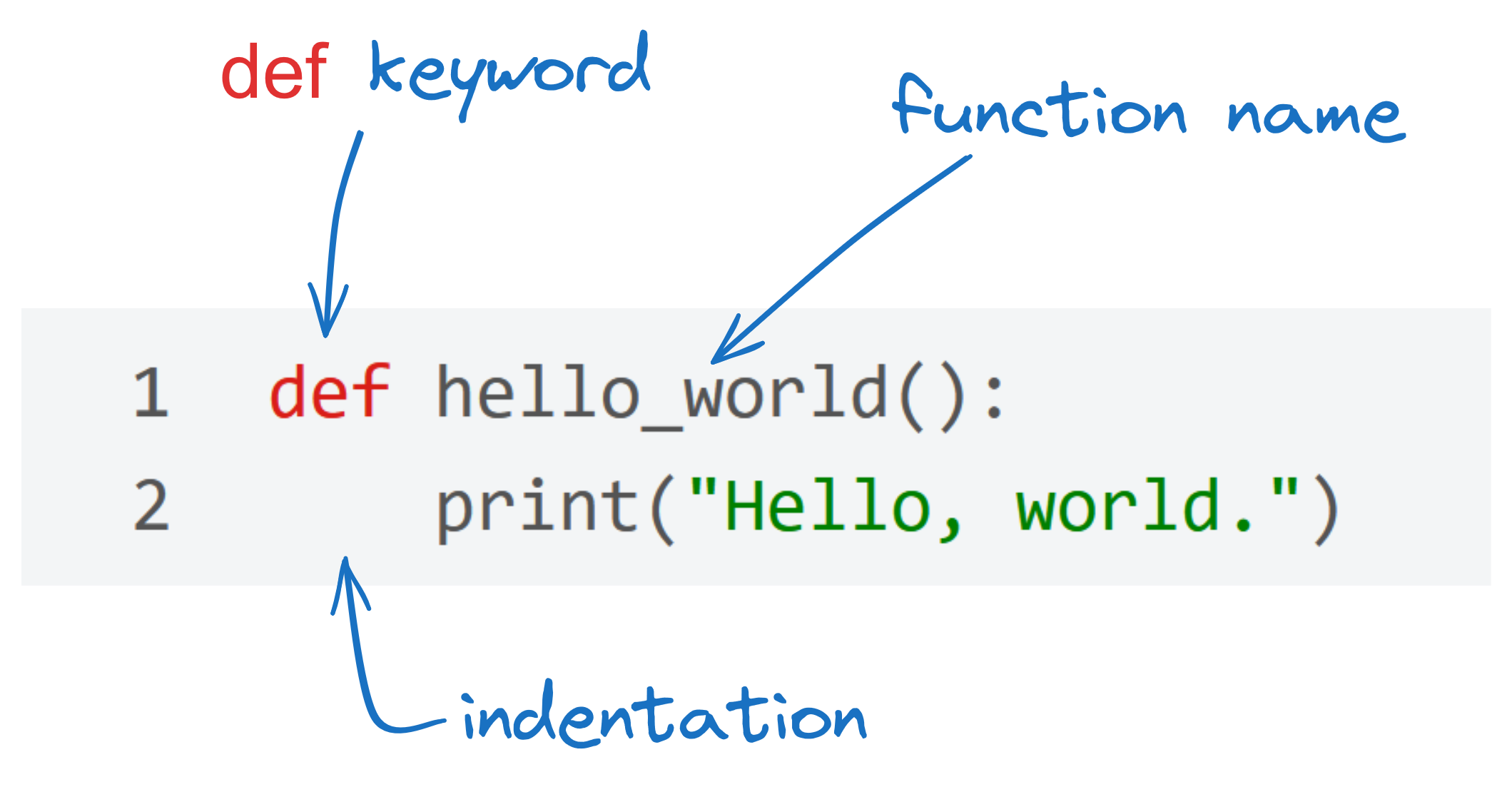
You will see many more examples of this kind of syntax, with a controlling statement, a colon, and an indented block. The indentation groups a block of code with the controlling statement. It says that everything indented belongs to, and is controlled by, the function definition (in this case).
If we run the simple_function.py program above (try it), there will be no output. We have defined the function, but we have not called it.
Calling a user-defined function is the same as calling a built-in function: use the function name, followed by parentheses.
Note that the function call occurs outside of the indented block of the function definition, and remember that while the function definition does not do anything by itself, you must define a function before using it (if it isn’t a built-in function like str() or print()).
NoneWe haven’t specified a return value for the function, so it returns nothing. In Python, “nothing” is represented by a special variable called None. It isn’t zero, it isn’t the string 'None', it’s nothing.
Trace the execution of this program:
simple_function_call.py
Three things are printed because there are three print statements:
= on line 4 is evaluated
int(40.1) returns int 40ii is printed= on line 6 is evaluated
hello_world()'Hello, world.' is printed by the function callNoneNone, is assigned to jj is printedTrace through this program, modify it, understand it. Ask questions if you have them.
It’s a short program, but it demonstrates several concepts that are fundamental to what we will learn in the future.
print() is a built-in function that returns None in addition to creating output at the console.
To demonstrate, let’s assign the return from print to a variable:
The print statement still creates the output we expected. If we print what was returned:
We have called built-in functions with arguments, such as int(40.1). We can also define functions that take arguments:
simple_function_call.py
Trace through the execution. Note how variable v is internal to the rounder function. Each time the function is called, \(v\) takes a different value.
Defining your own functions, especially functions that take arguments, is a powerful part of code reuse. Code reuse makes programming extremely powerful: you can write instructions once, and execute them many times, running them with different inputs to get different outputs.
returnWe have seen built-in functions that return a value after evaluation, such as float:
We have also seen how print does not return anything (None):
We have also written our own functions, so far without returning anything:
Calling the function results in the print statement running (and printed output). However, nothing is returned.
return ValuesWe can write functions so that they do return something. This is one of the most powerful concepts in computer programming.
To make your function return a value, use the keyword return at the end of the function:
When execution inside a function reaches a return statement:
return value is brought back to the function call
Note that nothing is printed by the function itself!
dprint on line 6A function can have any number of arguments. We’ve defined functions with no arguments and one argument. Multiple arguments are similar:
multiple_args.py
Arguments are passed into the function in the same position as the function call. Since 3 is the first argument, it becomes a when the function is called; likewise 4 becomes b.
Remember: if you define a function as needing a certain number of arguments, it must be called with that number of arguments. Otherwise, you’ll get an error.
Write a function fixed_sequence that takes no arguments and prints the following when called:
1 2 3 4Begin with this “starter code.”
practice1_3_4.py
Keep the two function calls: when you have written the body correctly, the program should print:
1 2 3 4
1 2 3 4Write a function variable_sequence that takes one argument, an integer, and prints out that integer and the next three consecutive integers in sequence:
variable_sequence(1) results in printed 1 2 3 4variable_sequence(2) results in printed 2 3 4 5variable_sequence(4) results in printed 4 5 6 7Begin with this “starter code.”
practice1_3_5.py
Keep the function calls: when you have written the body correctly, the program should print:
1 2 3 4
2 3 4 5
4 5 6 7Write a function return_sequence that takes one argument, an integer, and returns a string consisting of that integer and the next three consecutive integers in sequence:
return_sequence(1) results in returned string '1 2 3 4'return_sequence(2) results in returned string '2 3 4 5'return_sequence(4) results in returned string '4 5 6 7'Homework problems should always be your individual work. Please review the collaboration policy and ask the course staff if you have questions. Remember: Put comments at the start of each problem to tell us how you worked on it.
Double check your file names and printed output. These need to be exact matches for you to get credit.
Write a function squared_root that takes one argument, an integer, and prints out that integer, its square root, and its square, and the integer again, in sequence, with a single space in between each:
squared_root(1) results in printed 1 1 1 1squared_root(4) results in printed 4 2 16 4squared_root(0) results in printed 0 0 0 0You can expect the argument will always be positive integer that is a perfect square.
Begin with this “starter code.”
squared_root.py
Once the function is working, remove the function calls, and keep only the function definition. Submit as squared_root.py.
Hint: You can use the str() function to convert any numeric value into a string, and the + operator between strings to concatenate (join) them.
The program below is intended to implement the reverse_sequence function:
reverse_sequence(6) should print 6 4 2 0reverse_sequence(3) should print 3 1 -1 -3reverse_sqeuence.py
Fix/complete the function so that it works as intended. Submit as reverse_sequence.py.
This program will contain two functions.
Write one function, hello_world that simply prints Hello, world!.
Write a second function, call_hello_world that contains a function call to the first hello_world function.
call_hello_world.py
When finished:
Hello, world!hello_world) should change the output of the call to the second function
Before submitting, delete the call to call_hello_world. Keep the definitions. Submit as call_hello_world.py.
Write a function time_convert that converts from seconds to days. It should truncate at five digits after the decimal. Output should print in the following format:
time_convert(500) prints 500 seconds is 0.00578 daystime_convert(2000) prints 2000 seconds is 0.02314 daysSubmit as time_convert.py
There are 60 seconds in one minute. There are 60 minutes in one hour. There are 24 hours in one day.
You can truncate by:
math.floor on the resultThe factor of ten you choose (10, 100, 1000, etc.) will determine the decimal place of the truncation.
Write a function time_convert_return that performs the same conversion as the previous problem, but instead of printing the output, it returns a string:
time_convert_return(500) returns string '500 seconds is 0.00578 days'time_convert_return(2000) returns string '2000 seconds is 0.02314 days'Submit as time_convert_return.py
There are 60 seconds in one minute. There are 60 minutes in one hour. There are 24 hours in one day.
You can truncate by:
math.floor on the resultThe factor of ten you choose (10, 100, 1000, etc.) will determine the decimal place of the truncation.
Comments
A Python program consists of logical instructions for the programming language to execute. Sometimes, however, we want to include English (or other natural language) text for human beings to read.
We include this text in comments:
#.#starts the line)#comes after some valid code).